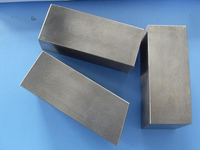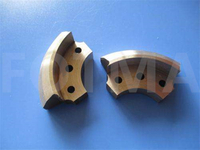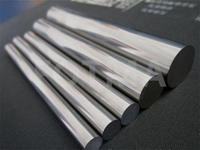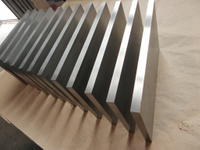Views: 72 Author: Site Editor Publish Time: 2018-05-02 Origin: Site
Tungsten products have a wide variety of trades, including raw materials and processed products. Raw material products refer to tungsten concentrates and junior- and intermediate-level smelting products such as tungstates, tungsten trioxide, oxides and hydroxides of unlisted tungsten, tungsten powder, tungsten carbide, and tungsten iron. Processed products mainly refer to tungsten, tungsten and unsintered mixes.
China has always been the world’s most important tungsten trading country, with tungsten products ranking first in the world. From 1949 to 1995, China mainly exported raw materials such as tungsten concentrates, tungstates, and ferrotungsten, among which tungsten concentrate exports accounted for about half of tungsten concentrate production. The export volume of tungsten products in China is far greater than domestic tungsten consumption. Until 2009, the export volume of tungsten products in China was less than the domestic tungsten consumption for the first time. It can be seen that the export of tungsten products in China has an important impact on the development of the domestic tungsten industry and the global tungsten supply and demand pattern. The United States, Europe, and Japan are the world’s major tungsten product import countries and regions. They mainly import tungsten raw materials, and at the same time they use high-quality processed products, high-value-added high-quality processed products, and high-end carbide cutting tools and complete sets of equipment. Export in form. This article aims to study the global trade of tungsten products, to understand China's position in the international tungsten market, from the perspective of tungsten trade status and export structure, to provide advice for China's tungsten industry development planning and industrial restructuring.
I. Analysis of Global Tungsten Product Imports and Exports
The global trade in tungsten products is relatively stable, with tungsten products import and export volume fluctuating around 40,000 tons (the amount of metal, the same below). The United States, Europe, and Japan are the major importing countries and regions, mainly importing raw materials such as tungsten concentrates, tungstates, and tungsten oxides. China, Vietnam, Russia, Canada and Rwanda are major exporting countries.
1.1 Global Export of Tungsten Products
From 2004 to 2016, the global volume of tungsten products fluctuates around 40,000 tons and has stabilized in recent years. China is the world’s largest exporter of tungsten products. However, with the increase in the use of scrap tungsten in developed countries such as the United States, Japan and Europe, exports of tungsten products from countries such as Vietnam, Canada, and Bolivia have increased, and foreign dependence on tungsten products in China has decreased. The export volume of tungsten products in China dropped from 28,000 t in 2004 to 22,000 t in 2016, and the global share dropped from 68% to 52%. In other countries such as Canada, Russia, Vietnam, Bolivia, and Rwanda, the total tungsten product export volume has increased from 3% in 2004 to 13% in 2016. Tungsten products in the United States, Europe, and Japan accounted for 35% of the world's total in 2016 (Figure 1).
Figure 1 Tungsten Carbide Exports in Major Countries and Regions from 2004 to 2016 and Chinese Exports
1.2 Import of Global Tungsten Products
In 2016, the global import volume of tungsten products was about 41,000 tons, of which tungsten products imported from the United States, Europe, and Japan accounted for 27%, 29%, and 18% of the world respectively, which together accounted for 73% of the world's total. The total imports of tungsten products in the United States, Japan, and Europe are around 30,000 tons, and the share of imports in the world fell from 82% in 2004 to 73% in 2016. Imports of tungsten products from South Korea, Canada, and Russia increased from 0.4 million tons in 2004 to 0.8 million tons in 2016, accounting for a global increase from 11% to 20%. China imports about 0.3 million tons of tungsten products, accounting for about 7% of the world's tungsten imports (Figure 2).
Figure 2 Tungsten Carbide Imports in Major Countries and Regions from 2004 to 2016 and Imports of U.S., Japan, and Europe
Second, China's tungsten trade
In 2016, the export volume of tungsten products in China was 22,000 tons (excluding carbide), the import volume was 0.3 million tons, and the net export volume was 19,000 tons.
2.1 China's tungsten export
In the early 1980s, due to long exports and self-competition, the export volume of tungsten products in China was difficult to control. The export products were mainly primary products such as tungsten concentrate, ferrotungsten and ammonium paratungstate. In order to protect and rationally develop cherished tungsten resources and increase economic efficiency, in 1993, the country used tungstates such as ammonium paratungstate and ammonium metatungstate, tungsten trioxide, oxides and hydroxides of tungsten not listed, tungsten powder and carbonization. Tungsten powder and other junior- and intermediate-level smelting products are subject to a quota system and a permit system. The export quota for tungsten products is around 17,000 tons, and tungsten concentrate exports have been banned since 2000.
From the structural changes in export products, it can be seen that the export of tungsten products in China has achieved a transformation from tungsten concentrates to tungsten smelting products and further to processed products. In 1985, exports of tungsten concentrates accounted for 61% of total exports, tungstates and ferrotungsten each accounted for 16%, and the three together accounted for 93%. In 1995, the export volume of quotas for tungsten products accounted for 95% of total exports, of which tungstate accounted for 74%, and tungsten concentrates were no longer exported. Since the 21st century, the export of tungstates has dropped, the exports of tungsten oxide and tungsten carbide have risen, and the export volumes of tungsten, tungsten and carbide have grown from zero to large. Tungstate exports fell to 13% in 2016, tungsten oxide accounted for 26%, cemented carbide accounted for 21%, tungsten carbide accounted for 16%, tungsten and iron accounted for 6% (Table 1 and Figure 3).
Table 1 Changes in exports of tungsten products and hard alloys in China
Figure 3 Changes in China's Tungsten Product Export Structure in 1985 and 2016
The 22-year export quota system for tungsten products and export tariff management have played a guiding role in regulating the export structure of tungsten products in China. The export structure of tungsten products in China has gradually changed, but the pattern of exports of tungsten raw materials is mainly No fundamental change has yet occurred. In 2015, China abolished its export quotas for tungsten products and export tariffs of 20% for ferro-tungsten. In 2016, the export volume of ferro-tungsten increased by more than five times compared with 2014, and the export volume of junior- and intermediate-level smelting products (formerly-quotaed tungsten products) increased by 14% over 2014. %, exports of tungsten iron and the original quota of tungsten products accounted for 81% of total exports (Table 1).
2.2 Import of Chinese Tungsten Products
Tungsten products imported from China include tungsten concentrates, sodium tungstate and tungsten powders. The volume of imported tungsten products is low, and tungsten product imports have declined in recent years. 2016 total imports of tungsten product of about 3 000 t, of which imports of tungsten concentrate 2 100 t, accounting for about 68% of imports. China has been importing tungsten concentrates since its processing and trade methods. The importing company is Xiamen Tungsten Industry (600549) located in the Fujian Free Trade Zone, not because of insufficient supply of tungsten concentrate in China.
III. Major tungsten products trade
3.1 Sources of data
The data in this section comes from the UN Trade Database and the China Customs Information Network. By comparing the trade codes of the two websites and judging the availability of data, this section deals with four types of tungsten concentrates, tungstates, ferrotungsten and tungsten powders. The trade analysis of tungsten raw materials was conducted. The HS codes for the four categories of products were 261100, 284180, 720280 and 810110 respectively.
3.2 Tungsten concentrate
Before the early 1990s, China was the world's leading tungsten concentrate exporter, with tungsten concentrate exports accounting for 74% of the world's total. In the early 1990s, China listed tungsten ore as a protective mineral. The output of tungsten concentrates declined in stages. After 1995, China basically stopped exporting tungsten concentrates. The structure of tungsten industry extends to smelting and processing. Russia, Canada, Bolivia, and Rwanda gradually became tungsten exporters after China.
In 2015, the global export of tungsten concentrates was 20,900 tons (physical quantity, the same below), the export countries were scattered, Canada's exports accounted for 23%, Russia accounted for 13%, Bolivia accounted for 12%, and the exports of the former three countries accounted for 48% of the world's total. Other tungsten concentrates are exported to state-owned Mongolia, Spain and Rwanda. In 2015, the global import of tungsten concentrates was 17,600 tons, and the main importing countries were China, the United States, Austria and Vietnam. The imports accounted for 27%, 23%, 21% and 12% of the world's total respectively, accounting for 83% of the world's total (Figure 4).
Figure 4: Trade volume (physical quantity) of major tungsten and ore concentrate countries in the world in 2015
3.3 Tungstate
Since the 1990s, China has gradually shifted its export of tungsten concentrates to smelting products such as tungstates, of which tungstate exports account for about 75% of the world's total. German tungstate exports once ranked second in the world, but since the global financial crisis in 2009, Germany no longer exports tungstates. In 2015, German Shitako relied on Vietnam's Nui Phao tungsten mine to build an ammonium paratungstate plant with a capacity of 6 500 t/a. Vietnam has become a major tungstate exporter outside China.
The global tungstate export volume is on a downward trend, and the tungsten product trade has gradually developed into high-end industries such as tungsten oxide, tungsten powder and tungsten carbide. In 2015, the global export of tungstate was 0.66 million tons, which was only 27% of the export volume of tungstate in 1995. China regulates the structure of the tungsten industry, and its export products have been transformed into medium- and high-level smelting products such as tungsten powder and tungsten carbide, as well as tungsten, tungsten and hard alloys. In 2015, China's tungstate exports accounted for 51% of the world's total, ranking first, and Vietnam accounting for 37%. The two countries together accounted for 88%. In 2015, the global import of tungstate was 0.95 million tons. The main importing countries were Germany, Japan and the United States. The total imports of the three countries accounted for 72% of the world's total.
3.4 Tungsten Iron and Tungsten Powder
In 2015, the global ferro-tungsten exports were 0.55 million tons, China accounted for 30%, ranking first, and Vietnam accounting for 19%, ranking second; in 2015, the global ferro-tungsten imports reached 0.72 million tons, and German, Japanese, Dutch, and Austrian imports accounted for the total 56%. In 2015, the global export of tungsten powder was 0.37 million tons. China's exports accounted for 30%, ranking first, and other major tungsten powder exporters were Finland, the United States, and South Korea; in 2015, the global import of tungsten powder was 0.56 million tons, and German and U.S. imports accounted for the total in the world. 51%.
IV. Trade Flow Analysis
The global tungsten trade pattern is stable, and trade flows are centered between tungsten-rich countries and tungsten-consuming countries and regions. China, Canada, Russia, Australia, Vietnam, and Bolivia are relatively rich in tungsten resources. China, the United States, Japan, and the European Union are global tungsten consumer centers. The output of tungsten concentrates in China ranks first in the world. In addition to satisfying domestic smelting and consumption, tungsten concentrates mainly supply tungstates, tungsten oxides and tungsten powders as raw materials for the world. At the same time, China has also imported tungsten concentrates for processing and processing. The import volume ranks first in the world. The main source countries are Russia, Mongolia, Rwanda and Bolivia.
According to data from the World Metals Statistics Bureau, Vietnam’s tungsten concentrate production has ranked second in the world in recent years. However, Vietnam’s tungsten concentrate production cannot meet its domestic new tungsten smelting capacity, and tungsten concentrates need to be imported from countries such as Russia, Australia and Rwanda. Tungsten concentrate is exported as tungstate after smelting. The export volume of tungstate is second only to China, mainly exported to Europe.
The United States is the largest tungsten consumer outside of China. Because there are no tungsten mines in production, the United States imports tungsten concentrates from Canada, Bolivia, Spain, and Australia, and imports tungstates, ferrotungsten, etc. from countries such as China, Vietnam, and Russia. Raw materials products. Japan also does not produce tungsten concentrates, which mainly import tungstates and ferrotungsten from China and Vietnam. Tungsten concentrate production in EU countries cannot meet its tungsten consumption, mainly from Russia, Canada and Bolivia, and tungsten and tungsten from China and Vietnam. Developed countries and regions in the United States, Japan, and Europe import tungsten raw material products from China, Vietnam, Russia, Canada, and other countries, while exporting products with high technological content and high added value.
V. Understanding and Suggestions
5.1 The main understanding
1) The global tungsten trade pattern is stable. The United States, Japan, and the European Union are the major importing countries and regions. China and Vietnam are the major exporters. The global tungsten products trade develops to the middle and high-end of the industrial chain. The developed countries in the United States, Japan, and the European Union have reduced their dependence on tungsten products in China, and exports of tungsten products in Vietnam, Canada, and Bolivia increased.
2) In 2015, China exported 25,000 tons of cemented carbide tungsten products (Table 1). The current global tungsten demand was approximately 62,000 tons, of which China's original tungsten demand was 33,000 tons and foreign original tungsten demand was 29,000 tons. China Supply Tungsten products account for 86% of foreign original tungsten demand. Compared with the proportion of tungsten resources in China accounting for 57% of the world's total, it is clear that the current export volume and global share is too high.
3) Tungsten ore mining in China must meet domestic consumption and be exported in large quantities. Excessive export volume will inevitably result in excessive depletion of resources. In 2015, the total export volume of tungsten products in China and the original tungsten consumption amounted to 58,000 tons, and the total control index of ultra-high tungsten concentrates was 11,000 tons, which also reflected the excessive export volume of tungsten products in China.
4) China's export structure, mainly exporting raw materials with high energy consumption and poor economic returns, has not yet fundamentally changed. For more than 20 years, China’s export of tungsten products has gradually achieved a transformation from tungsten concentrates to tungsten intermediate smelting products, and further to tungsten powder and other advanced raw materials, hard alloys, tungsten and tungsten materials, but export quotas and exports of tungsten products. After the abolition of tariffs, exports of ferro-tungsten and the original quota of tungsten products showed a substantial increase. In 2016, exports of tungsten and iron and the original quota of tungsten products still accounted for 81% of tungsten export.
5.2 Suggestions
China has long been a major supplier of the international tungsten market, but it has not yet had enough capacity to guide the market. Tungsten market entered the price increase → production increase → supply exceeds demand → the price of the old road. In order to make the tungsten mineral resources more rationally developed and utilized, the company will obtain better economic benefits, and put forward the following two suggestions from the perspective of trade.
1) Reduce the export volume of raw materials products. After the abolition of export quotas and export tariffs for tungsten products, it is necessary to further strictly control the production capacity and output of tungsten concentrates and primary smelting products, eliminate backward smelting production capacity, and eliminate low-level duplicate construction. Reduce the output of raw material products, thereby reducing the export supply. Reducing supply is the fundamental way to solve the current weak rise in tungsten prices.
2) Improve export structure and increase export economic efficiency. We will adjust the structure of the tungsten industry to improve the research and development of high-quality and high-end processing and deep processing products, promote product upgrades, and export products to high-value-added products. At present, high-end products that still need to be imported should adopt policy measures to support and encourage the localization of high-end products.





